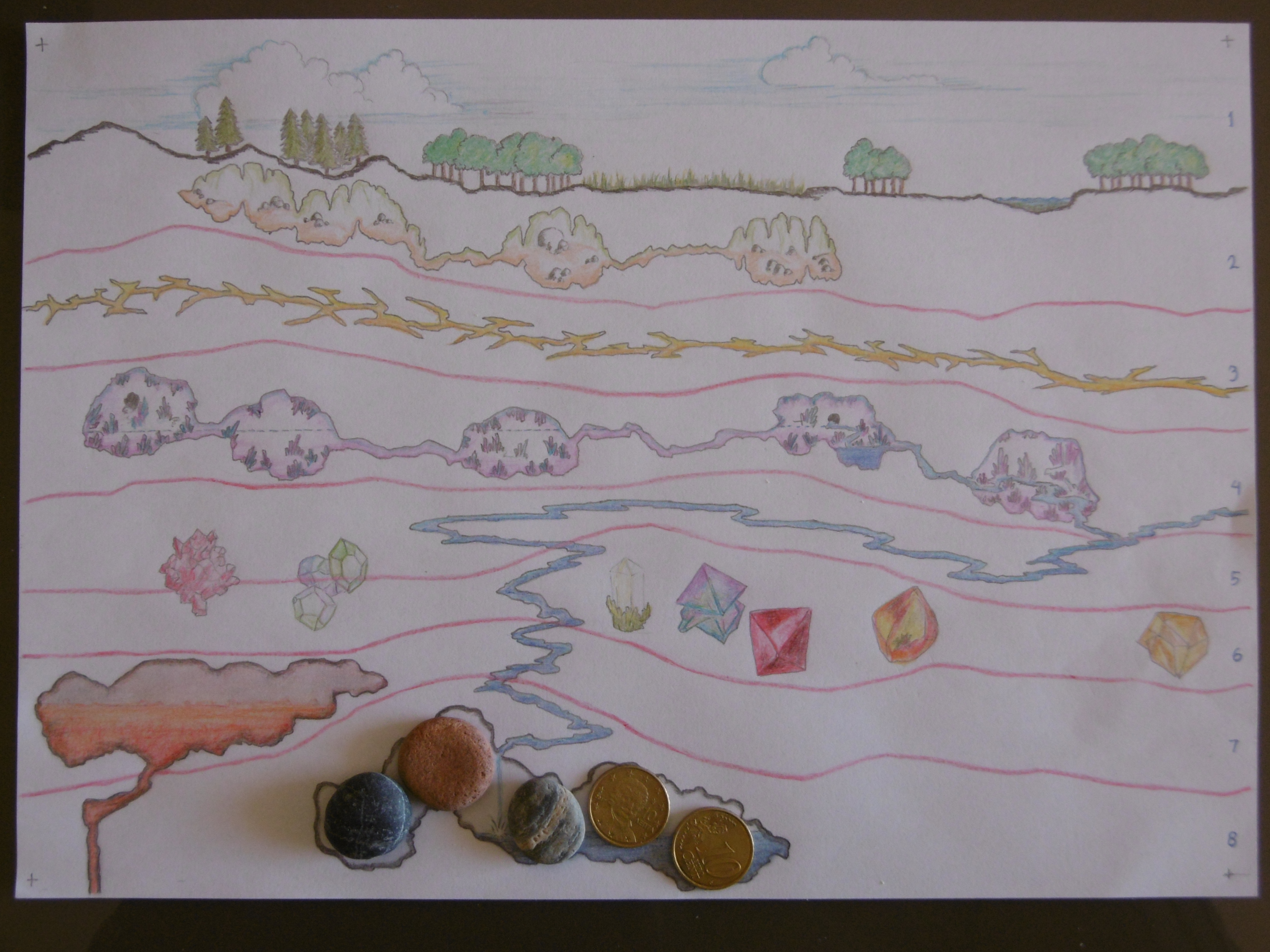Using How to Host a Dungeon, the game map is divided into eight “strata” (enumerated on the right, map below). Each game stratum is made up of one or more geologic strata. I use the same term for both, I think without too much confusion. Each enumerated stratum also contains a feature. In Wyrm Dawn’s primordial age, many features are created by two rivers—one surface, another subsurface—and an earthquake.

We are looking north. To the right is east; left west.
Here I describe each enumerated stratum. A table below summarizes.
1. Surface
A languid river meanders across its floodplain carved in a limestone bed. It deposits rich soil on its banks and seeps through porous rock to form a subterranean stream (stratum 4). From the soil grow lush grasses and primeval woods: deciduous on the flood plain, conifer higher up.
2. Dead Caves
Where the river spares the limestone, hills remain. Beneath them, limestone caverns, formed by river water in an earlier epoch, are now dry.1
3. Gold Vein
The result of an earthquake deep below the surface, the fissure struck through a layer of granite and quartz, forming the gold vein in an instant.2
4. Crystal Caverns
The subterranean stream comes out in this limestone layer to create these caverns. When the river runs nearer the hills, another stream gives into the western cave.3 A previous water line is still visible throughout the complex. Even where the stream doesn’t run, the caverns are still damp, creating selenite crystals.4, 5
5. Subterranean River
This subterranean river etches a course through limestone. It is swift but navigable from the east to where it falls through basalt (stratum 6).
6. Gem Deposits
A stratum of basalt contains gem deposits.
7. Magma Chamber
The earthquake also opened a fissure in this granite stratum from a magma source far below.
8. Mother of Dragons
Earth, shuddering in her labor, opened this large cavern complex to spawn a primordial wyrm. The parthenogenic creature emerged fully grown into the earth. She now seeks nourishment, so to lay her eggs.
Strata Summary
| Stratum | Primary rock | Feature |
|---|---|---|
| 1 | Soil | Biomes: deciduous and conifer woods, river, grassland, hills |
| 2 | Limestone, green6 | Caves: connected caverns |
| 3 | Granite, quartz | Ore: gold vein |
| 4 | Limestone, blue6 | Biome: crystal caverns |
| 5 | Limestone, yellow6 | Water: river |
| 6 | Basalt | Gems: deposits |
| 7 | Granite | Magma: chamber |
| 8 | Limestone, red6 | Nexus: mother of monsters—dragons |
The stage now set, the Age of Civilization begins.
Notes
1 A tunnel from the surface leads to the dead caves’ western cavern.
2 It seems our mundane world still wields much magic. A study described in this Nature article proposes that a gold vein can indeed be formed by an earthquake “in an instant.”
3 Like the dead caves above, a tunnel from the surface must lead down to the western cave mouth in the crystal caverns, while a tunnel to the eastern mouth is submerged. I’d look for a whirlpool in the surface river.
4 For the crystal caverns, I’m inspired by the selenite crystals from Mexico’s Naica cave.
5 Selenite, a variety of gypsum, is transparent and colorless, but impurities can give it a tinge of color, including blue and magenta, like a certain pair of game boxes—I’m going with that.
6 Who knew limestone comes in different colors? Savvy explorers might know how deep they have ventured by the kind and color of rock.
Really cool stuff
Pingback: Viggo’s Histories – DONJON LANDS